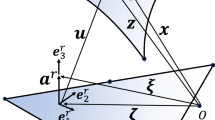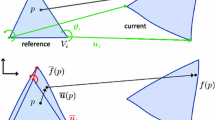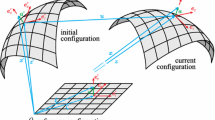Abstract
This work presents a simple finite element implementation of a geometrically exact and fully nonlinear Kirchhoff–Love shell model. Thus, the kinematics are based on a deformation gradient written in terms of the first- and second-order derivatives of the displacements. The resulting finite element formulation provides \(C^1\)-continuity using a penalty approach, which penalizes the kinking at the edges of neighboring elements. This approach enables the application of well-known \(C^0\)-continuous interpolations for the displacements, which leads to a simple finite element formulation, where the only unknowns are the nodal displacements. On the basis of polyconvex strain energy functions, the numerical framework for the simulation of isotropic and anisotropic thin shells is presented. A consistent plane stress condition is incorporated at the constitutive level of the model. A triangular finite element, with a quadratic interpolation for the displacements and a one-point integration for the enforcement of the \(C^1\)-continuity at the element interfaces leads to a robust shell element. Due to the simple nature of the element, even complex geometries can be meshed easily, which include folded and branched shells. The reliability and flexibility of the element formulation is shown in a couple of numerical examples, including also time dependent boundary value problems. A plane reference configuration is assumed for the shell mid-surface, but initially curved shells can be accomplished if one regards the initial configuration as a stress-free deformed state from the plane position, as done in previous works.













Similar content being viewed by others
Notes
Therein the author introduced the double-cross product: \(.\)
References
Antman S (1995) Nonlinear problems of elasticity. Springer, New York
Ball J (1977a) Convexity conditions and existence theorems in non-linear elasticity. Arch Ration Mech Anal 63:337–403
Ball J (1977b) Constitutive inequalities and existence theorems in nonlinear elastostatics. In: Knops RJ (ed) Symposium on non-well posed problems and logarithmic convexity. Springer-lecture notes in mathematics, vol 316
Balzani D, Neff P, Schröder J, Holzapfel G (2006) A polyconvex framework for soft biological tissues. Adjustment to experimental data. Int J Solids Struct 43(20):6052–6070
Balzani D, Gruttmann F, Schröder J (2008) Analysis of thin shells using anisotropic polyconvex energy densities. Comput Methods Appl Mech Eng 197:1015–1032
Balzani D, Schröder J, Neff P (2010) Applications of anisotropic polyconvex energies: thin shells and biomechanics of arterial walls. In: Poly-, quasi- and rank-one convexity in applied mechanics. CISM course and lectures, vol 516. Springer, New York
Başar Y, Diing Y (1997) Shear deformation models for large-strain shell analysis. Int J Solids Struct 34:1687–1708
Başar Y, Grytz Y (2004) Incompressibility at large strains and finite-element implementation. Acta Mech 168:75–101
Betsch P, Gruttmann F, Stein E (1996) A 4-node finite shell element for the implementation of general hyperelastic 3D-elasticity at finite strains. Comput Methods Appl Mech Eng 130:57–79
Bischoff M, Ramm E (1997) Shear deformable shell elements for large strains and rotations. Int J Numer Methods Eng 40(23):4427–4449
Boehler JP (1978) Lois de comportement anisotrope des milieux continus. J Méc 17(2):153–190
Boehler J (1979) A simple derivation of representations for non-polynomial constitutive equations in some cases of anisotropy. Z angew Math Mech 59:157–167
Boehler JP (1987) Introduction to the invariant formulation of anisotropic constitutive equations. In: Boehler JP (ed) Applications of tensor functions in solid mechanics, vol 292. International Centre for Mechanical Sciences, Springer, Vienna, p 13–30. ISBN 978-3-211-81975-3
Bonet J, Gil AJ, Ortigosa R (2016) On a tensor cross product based formulation of large strain solid mechanics. Int J Solids Struct. doi:10.1016/j.ijsolstr.2015.12.030. ISSN 0020-7683
Campello EMB, Pimenta PM, Wriggers P (2003) A triangular finite shell element based on a fully nonlinear shell formulation. Comput Mech 31:505–518
Campello EMB, Pimenta PM, Wriggers P (2011) An exact conserving algorithm for nonlinear dynamics with rotational DOFs and general hyperelasticity. Comput Mech 48:195–211
Ciarlet PG (1988) Mathematical elasticity: three-dimensional elasticity, vol I. Elsevier, Amsterdam
Ciarlet PG (1993) Mathematical elasticity: three-dimensional elasticity, vol 1. Elsevier, Amsterdam
Cirak F, Long Q (2011) Subdivision shells with exact boundary control and non-manifold geometry. Int J Numer Methods Eng 88(9):897–923
Cirak F, Ortiz M (2001) Fully C1-conforming subdivision elements for finite deformation thin-shell analysis. Int J Numer Methods Eng 51(7):813–833
Dacorogna B (1989) Direct methods in the calculus of variations. Applied mathematical sciences, vol 78, 1st edn. Springer, Berlin,
de Boer R (1982) Vektor-und Tensorrechnung für Ingenieure. Springer, Berlin
Ebbing V, Balzani D, Schröder J, Neff P, Gruttmann F (2009) Construction of anisotropic polyconvex energies and applications to thin shells. Comput Mater Sci 46(3):639–641
Hughes TJR, Tezduyar TE (1981) Finite elements based upon Mindlin plate theory with particular reference to the four-node bilinear isoparametric element. J Appl Mech 48(3):587–596
Hughes TJR, Cottrell JA, Bazilevs Y (2005) Isogeometric analysis: CAD, finite elements, NURBS, exact geometry and mesh refinement. Comput Methods Appl Mech Eng 194:4135–4195
Ivannikov V, Tiago C, Pimenta PM (2014) Meshless implementation of the geometrically exact Kirchhoff–Love shell theory. Int J Numer Methods Eng 100:1–39
Ivannikov V, Tiago C, Pimenta PM (2015) Generalization of the C1 TUBA plate finite elements to the geometrically exact Kirchhoff–Love shell model. Comput Methods Appl Mech Eng
Kiendl J, Bletzinger K-U, Linhard J, Wüchner R (2009) Isogeometric shell analysis with Kirchhoff–Love elements. Comput Methods Appl Mech Eng 198(49–52):3902–3914
Kiendl J, Bazilevs Y, Hsu M-C, Wüchner R, Bletzinger K-U (2010) The bending strip method for isogeometric analysis of Kirchhoff–Love shell structures comprised of multiple patches. Comput Methods Appl Mech Eng 199(37–40):2403–2416
Korelc J (1997) Automatic generation of finite-element code by simultaneous optimization of expressions. Theor Comput Sci 187(1):231–248
Korelc J (2002) Multi-language and multi-environment generation of nonlinear finite element codes. Eng Comput 18:312–327
Korelc J, Wriggers P (2016) Automation of finite element methods, 1st edn. Springer. doi:10.1007/978-3-319-39005-5
Malkus D, Hughes TJR (1978) Mixed finite element methods—reduced and selective integration techniques: a unification of concepts. Comput Methods Appl Mech Eng 15(1):63–81
Marsden JE, Hughes TJR (1983) Mathematical foundations of elasticity. Dover Publications, Inc., New York
Millan D, Rosolen A, Arroyo M (2010a) Nonlinear manifold learning for meshfree finite deformation thin-shell analysis. Int J Numer Methods Eng 93(7):685–713
Millan D, Rosolen A, Arroyo M (2010b) Thin shell analysis from scattered points with maximum-entropy approximants. Int J Numer Methods Eng 85(6):723–751
Ojeda R, Prusty BG, Lawrence N, Thomas G (2007) A new approach for the large deflection finite element analysis of isotropic and composite plates with arbitrary orientated stiffeners. Finite Elem Anal Des 43:989–1002
Oliveira IP, Campello EMB, Pimenta PM (2006) Finite element analysis of the wrinkling of orthotropic membranes. In: III European conference on computational mechanics: solids, structures and coupled problems in engineering: book of abstracts. Springer, Dordrecht, p 661–673
Ota N, Wilson L, Gay A, Neto S, Pellegrino S, Pimenta PM (2016) Nonlinear dynamic analysis of creased shells. Finite Elem Anal Des 121:64–74
Pimenta PM (1993) On the geometrically-exact finite-strain shell model. In: Proceeding of the third Pan-American congress on applied mechanics, PACAM III, January 1993. Escola Politecnica da Universidade de Sao Paulo, Sao Paulo, p 616–619
Pimenta PM, Campello EMB (2009) Shell curvatures as an initial deformation: a geometrically exact finite element approach. Int J Numer Methods Eng 78:1094–1112
Pimenta PM, Almeida Neto ES, Campello EMB (2010) A fully nonlinear thin shell model of Kirchhoff–Love type. In: New trends in thin structures: formulation, optimization and coupled problems. Springer Vienna, Vienna, p 29–58
Rabczuk T, Areias PMA, Belytschko T (2007) A meshfree thin shell method for non-linear dynamic fracture. Int J Numer Methods Eng 72:524–548
Samanta A, Mukhopadhyay M (1999) Finite element large deflection static analysis of shallow and deep stiffened shells. Finite Elem Anal Des
Sansour C, Kollmann F (2000) Families of 4-node and 9-node finite elements for a finite deformation shell theory. An assessment of hybrid stress, hybrid strain and enhanced strain elements. Comput Mech 24:435–447
Schröder J (2010) Anisotropic polyconvex energies. In: Poly-, quasi- and rank-one convexity in applied mechanics. Springer, Vienna, p 53–105
Schröder J, Neff P (2001) On the construction of polyconvex anisotropic free energy functions. In: Miehe C (ed) Proceedings of the IUTAM Symposium on computational mechanics of solid materials at large strains. Kluwer Academic Publishers, Dordrecht, p 171–180
Schröder J, Neff P (2003) Invariant formulation of hyperelastic transverse isotropy based on polyconvex free energy functions. Int J Solids Struct 40:401–445
Schröder J, Neff P (eds, 2010) Poly-, quasi- and rank-one convexity in applied mechanics, CISM book, vol 516. Springer, Wien
Schröder J, Neff P, Ebbing V (2008) Anisotropic polyconvex energies on the basis of crystallographic motivated structural tensors. J Mech Phys Solids 56(12):3486–3506
Schröder J, Balzani D, Stranghöner N, Uhlemann J, Gruttmann F, Saxe K (2011) Membranstrukturen mit nicht-linearem anisotropem materialverhalten - aspekte der materialprüfung und der numerischen simulation 86:381–389
Silhavy M (1997) The mechanics and thermodynamics of continuous media. Springer, Berlin
Simo JC, Fox DD (1989) On a stress resultant geometrically exact shell model. Part I: formulation and optimal parametrization. Comput Methods Appl Mech Eng 72:267–304
Simo JC, Rifai MS (1990) A class of assumed strain methods and the method of incompatible modes. Int J Numer Methods Eng 29:1595–1638
Simo JC, Fox DD, Rifai MS (1989) On a stress resultant geometrically exact shell model. Part II: the linear theory; computational aspects. Comput Methods Appl Mech Eng 73:53–92
Simo JC, Fox DD, Rifai MS (1990) On a stress resultant geometrically exact shell model. Part III: computational aspects of the nonlinear theory. Comput Methods Appl Mech Eng 79:21–70
Truesdell C, Noll W (2004) The non-linear field theories of mechanics, 3rd edn. Springer, Berlin
Acknowledgments
The first and third authors gratefully acknowledge support by the Deutsche Forschungsgemeinschaft in the Priority Program 1748 “Novel finite elements for anisotropic media at finite strain” under the Project “Reliable Simulation Techniques in Solid Mechanics, Development of Non-standard Discretization Methods, Mechanical and Mathematical Analysis” (SCHR 570/23-1). In addition to that the author P. M. Pimenta expresses his acknowledgement to the Alexander von Humboldt Foundation for the Georg Forster Award that made possible his stays at the Universities of Duisburg-Essen and Hannover in Germany in the triennium 2015–2017 as well as to the French and Brazilian Governments for the Chair CAPES-Sorbonne that made possible his stay at Sorbonne Universités during the year of 2016 on a leave from the University of São Paulo.
Author information
Authors and Affiliations
Corresponding author
Rights and permissions
About this article
Cite this article
Viebahn, N., Pimenta, P.M. & Schröder, J. A simple triangular finite element for nonlinear thin shells: statics, dynamics and anisotropy. Comput Mech 59, 281–297 (2017). https://doi.org/10.1007/s00466-016-1343-6
Received:
Accepted:
Published:
Issue Date:
DOI: https://doi.org/10.1007/s00466-016-1343-6




